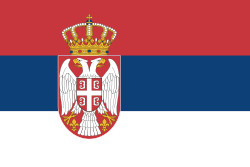The following outline is provided as an overview of and topical guide to Serbia:
Contents
- General reference
- Geography of Serbia
- Environment of Serbia
- Natural geographic features of Serbia
- Regions of Serbia
- Ecoregions of Serbia
- Administrative divisions of Serbia
- Districts of Serbia
- Municipalities of Serbia
- Demography of Serbia
- Government and politics of Serbia
- Branches of the government of Serbia
- Foreign relations of Serbia
- Law and order in Serbia
- Military of Serbia
- Local government in Serbia
- History of Serbia
- Culture of Serbia
- Art in Serbia
- Sports in Serbia
- Economy and infrastructure of Serbia
- Education in Serbia
- Science in Serbia
- See also
- References
- External links
Serbia – landlocked sovereign country located in Southeastern Europe and comprising the southern portion of the Pannonian Plain and a central portion of the Balkan Peninsula. [1] Serbia is bordered by Hungary to the north; Romania and Bulgaria to the east; North Macedonia and constitutionally only, Albania (via Kosovo, a disputed territory over which Serbia has no control, thus no direct access to Albania) [2] to the south; and Croatia, Bosnia and Herzegovina and Montenegro to the west. The capital of Serbia is Belgrade.
For centuries, shaped at cultural boundaries between East and West, a powerful medieval kingdom – later renamed the Serbian Empire – occupied much of the Balkans. Torn by domestic feuds, Ottoman, Hungarian, and later, Austrian incursions, the Serbian state collapsed by the mid-16th century. The positive outcome of the Serbian revolution in 1817 marked the birth of modern Serbia. Within a century it reacquired Kosovo, Raška and Vardar Macedonia from the Ottoman Empire. Likewise, in 1918 the former autonomous Habsburg crownland of Vojvodina proclaimed its secession from Austria-Hungary to unite with Serbia, preceded by the Syrmia region.
The current borders of the country were established following the end of World War II, when Serbia became a federal unit within the Socialist Federal Republic of Yugoslavia. Serbia became an independent state again in 2006, after Montenegro left the union that formed after the dissolution of Yugoslavia in 1990s.
In February 2008, the parliament of Kosovo unilaterally declared independence from Serbia. Serbia's government, as well as the UN Security Council, have not recognized Kosovo's independence. The response from the international community has been mixed. Serbia is a member of the United Nations, the Organization for Security and Co-operation in Europe, and the Council of Europe, and is an associate member of the European Union.


